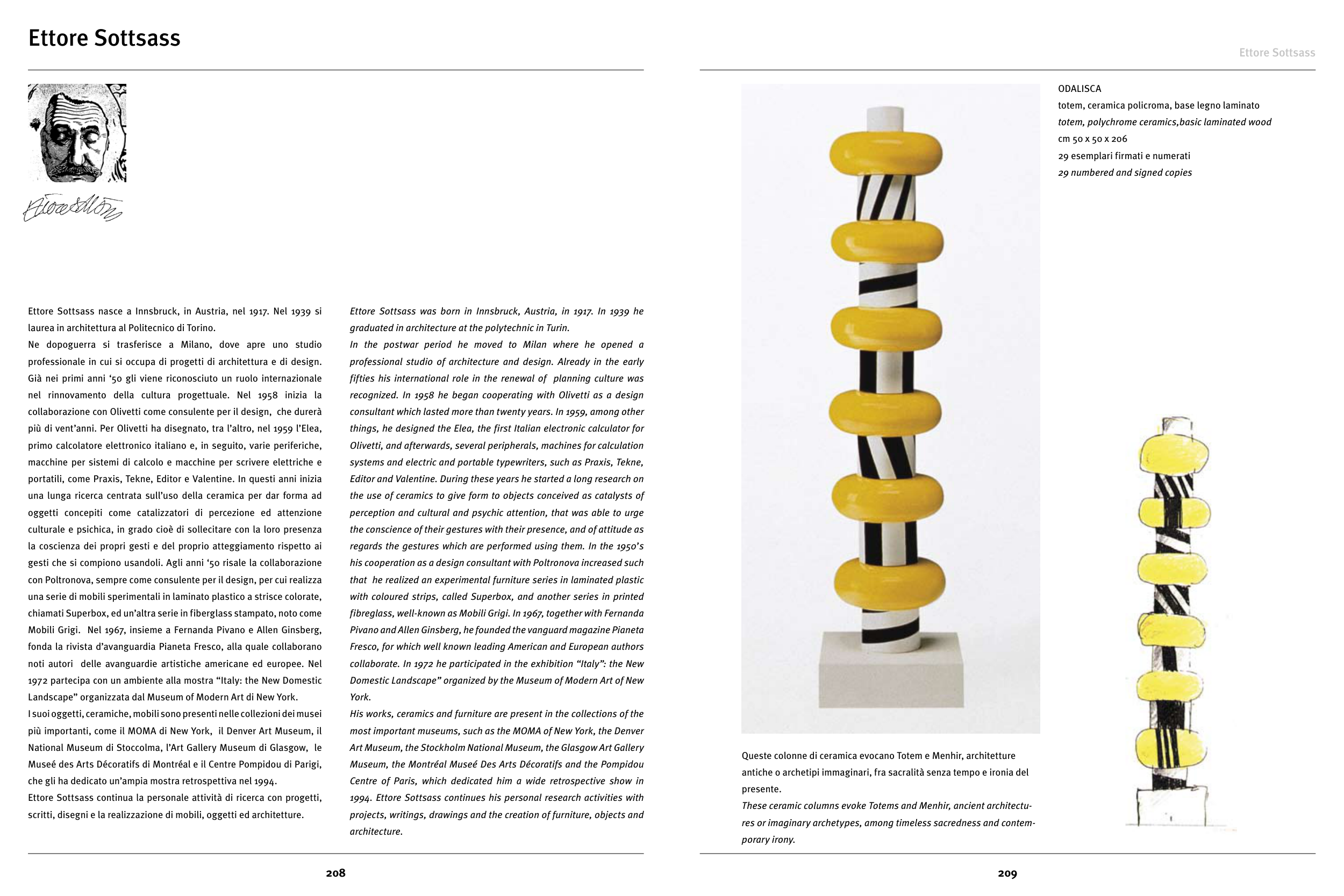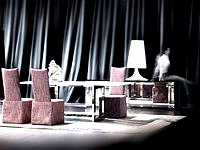ODALISCA
totem, ceramica policroma, base legno laminato
totem, polychrome ceramics,basic laminated wood
cm 50 x 50 x 206
29 esemplari firmati e numerati
29 numbered and signed copies
Queste colonne di ceramica evocano Totem e Menhir, architetture
antiche o archetipi immaginari, fra sacralità senza tempo e ironia del
presente.
These ceramic columns evoke Totems and Menhir, ancient architectu-
res or imaginary archetypes, among timeless sacredness and contem-
porary irony.
Ettore Sottsass
Ettore Sottsass nasce a Innsbruck, in Austria, nel 1917. Nel 1939 si
laurea in architettura al Politecnico di Torino.
Ne dopoguerra si trasferisce a Milano, dove apre uno studio
professionale in cui si occupa di progetti di architettura e di design.
Già nei primi anni ‘50 gli viene riconosciuto un ruolo internazionale
nel rinnovamento della cultura progettuale. Nel 1958 inizia la
collaborazione con Olivetti come consulente per il design, che durerà
più di vent’anni. Per Olivetti ha disegnato, tra l’altro, nel 1959 l’Elea,
primo calcolatore elettronico italiano e, in seguito, varie periferiche,
macchine per sistemi di calcolo e macchine per scrivere elettriche e
portatili, come Praxis, Tekne, Editor e Valentine. In questi anni inizia
una lunga ricerca centrata sull’uso della ceramica per dar forma ad
oggetti concepiti come catalizzatori di percezione ed attenzione
culturale e psichica, in grado cioè di sollecitare con la loro presenza
la coscienza dei propri gesti e del proprio atteggiamento rispetto ai
gesti che si compiono usandoli. Agli anni ‘50 risale la collaborazione
con Poltronova, sempre come consulente per il design, per cui realizza
una serie di mobili sperimentali in laminato plastico a strisce colorate,
chiamati Superbox, ed un’altra serie in fiberglass stampato, noto come
Mobili Grigi. Nel 1967, insieme a Fernanda Pivano e Allen Ginsberg,
fonda la rivista d’avanguardia Pianeta Fresco, alla quale collaborano
noti autori delle avanguardie artistiche americane ed europee. Nel
1972 partecipa con un ambiente alla mostra “Italy: the New Domestic
Landscape” organizzata dal Museum of Modern Art di New York.
I suoi oggetti, ceramiche, mobili sono presenti nelle collezioni dei musei
più importanti, come il MOMA di New York, il Denver Art Museum, il
National Museum di Stoccolma, l’Art Gallery Museum di Glasgow, le
Museé des Arts Décoratifs di Montréal e il Centre Pompidou di Parigi,
che gli ha dedicato un’ampia mostra retrospettiva nel 1994.
Ettore Sottsass continua la personale attività di ricerca con progetti,
scritti, disegni e la realizzazione di mobili, oggetti ed architetture.
Ettore Sottsass was born in Innsbruck, Austria, in 1917. In 1939 he
graduated in architecture at the polytechnic in Turin.
In the postwar period he moved to Milan where he opened a
professional studio of architecture and design. Already in the early
fifties his international role in the renewal of planning culture was
recognized. In 1958 he began cooperating with Olivetti as a design
consultant which lasted more than twenty years. In 1959, among other
things, he designed the Elea, the first Italian electronic calculator for
Olivetti, and afterwards, several peripherals, machines for calculation
systems and electric and portable typewriters, such as Praxis, Tekne,
Editor and Valentine. During these years he started a long research on
the use of ceramics to give form to objects conceived as catalysts of
perception and cultural and psychic attention, that was able to urge
the conscience of their gestures with their presence, and of attitude as
regards the gestures which are performed using them. In the 1950’s
his cooperation as a design consultant with Poltronova increased such
that he realized an experimental furniture series in laminated plastic
with coloured strips, called Superbox, and another series in printed
fibreglass, well-known as Mobili Grigi. In 1967, together with Fernanda
Pivano and Allen Ginsberg, he founded the vanguard magazine Pianeta
Fresco, for which well known leading American and European authors
collaborate. In 1972 he participated in the exhibition “Italy”: the New
Domestic Landscape” organized by the Museum of Modern Art of New
York.
His works, ceramics and furniture are present in the collections of the
most important museums, such as the MOMA of New York, the Denver
Art Museum, the Stockholm National Museum, the Glasgow Art Gallery
Museum, the Montréal Museé Des Arts Décoratifs and the Pompidou
Centre of Paris, which dedicated him a wide retrospective show in
1994. Ettore Sottsass continues his personal research activities with
projects, writings, drawings and the creation of furniture, objects and
architecture.
Ettore Sottsass
20�
20�







